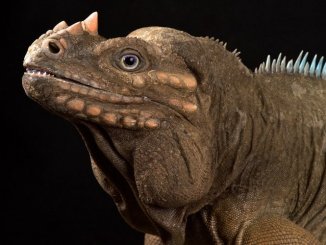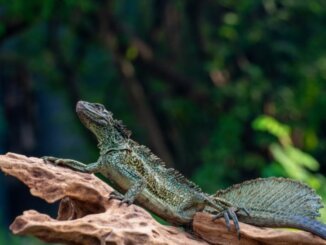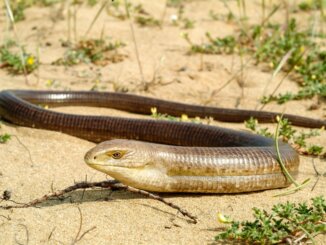Originating from Northern Africa, Peter’s banded skink has only recently been introduced to the reptile market.
As a result, it is pretty uncommon. This unique reptile is short and stout. It is yellow or orange with black stripes on its back. Its tail, limbs, and digits are short.
Because little is known about them and their care requirements, Peter’s banded skinks should be cared for by experienced keepers. With expertise and patience, these can be rewarding reptiles to raise.
Peter’s Banded Skink Overview
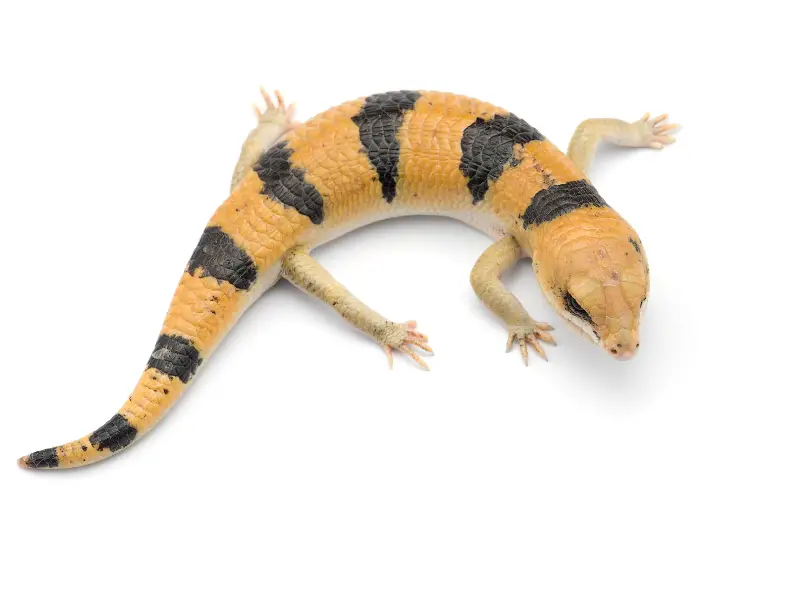
| Common name | Peter's Banded Skink |
| Scientific name | Scincopus fasciatus |
| Natural habitat | Sahelian and southern Saharan regions of northern Africa |
| Adult size | 8" to 10.5" |
| Average lifespan | 15-20 years |
| Diet | Omnivorous |
| Housing | Medium to large enclosure (minimum of 36" long) |
| Experience | Advanced |
Origin
The Peter’s banded skink (Scincopus fasciatus) originates from the Sahel region of Northern Africa.
These reptiles are accustomed to hot, sandy, semi-arid environments. They are often found in short grasslands, savannas, and shrublands.
It’s normal for these skinks to spend lots of time underground. They even enjoy sleeping with their heads buried in the sand, so don’t worry if you find them like this.
These reptiles are relatively new to the reptile trade. In the wild, their conservation status is classified as Least Concern, and they are not endangered.
Appearance And Behavior
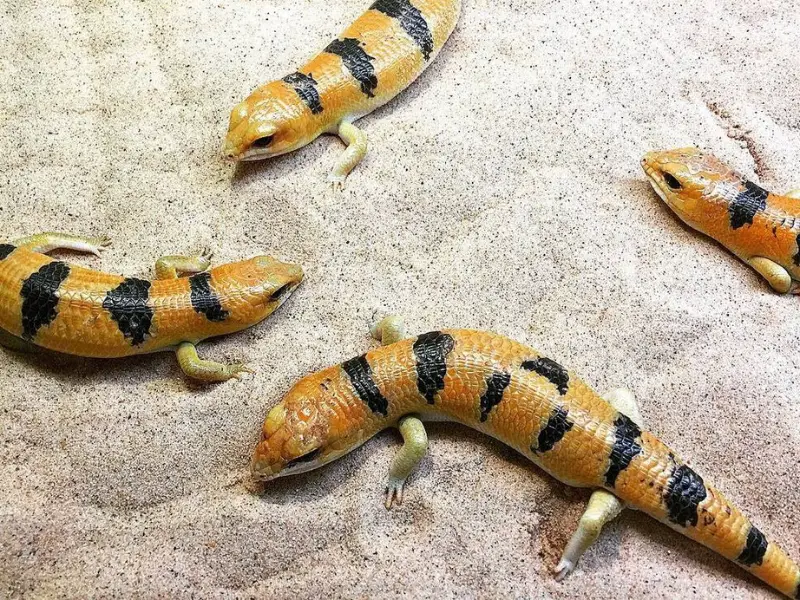
Peter’s banded skinks are yellow or orange, with smooth scales and black bands across their backs.
They’re relatively small lizards with short tails, limbs, and digits. They have dark black eyes, which give them a mysterious look.
Males have larger and broader heads than females and females tend to have larger cloacal glands than males. However, note that these measures are not a reliable way to sex these lizards.
Only radiography can accurately pinpoint the sex of Peter’s banded skink.
These reptiles are pretty tame and are relatively calm when handled. Although this sounds like a perfect combination for a beginner-friendly reptile, it’s easy to make mistakes with these lizards.
Their care is best left to advanced reptile keepers who have experience in caring for skinks and lizards.
Size And Lifespan
These skinks are small to medium-sized lizards. An adult will grow up to between 8″ and 10.5″. They tend to live for an average of 15 to 20 years.
Temperament
The Peter’s banded skink has been described as similar in temperament to a bearded dragon. They are tame with a gentle nature. Unlike most other reptiles, they seem to like it when humans handle them.
They can be housed in pairs or groups and appear to get along well. However, incidences of injury can sometimes occur when one mistakes another for prey.
It’s uncommon for these reptiles to bite.
Housing The Peter’s Banded Skink
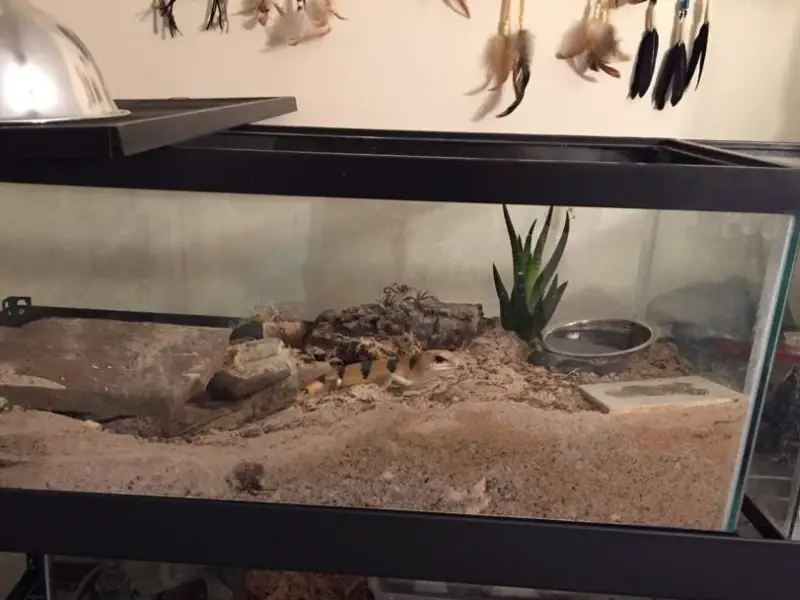
Peter’s banded skinks are used to tropical climates, which you should try to mimic in their terrarium. The right temperature, lighting, humidity, and enclosure size are essential in housing this skink.
As mainly terrestrial reptiles, floor space is more important than height.
Let’s look at the specific requirements you’ll need to meet.
Enclosure Size
Generally speaking, they prefer wide spaces rather than tall spaces. So, make sure your skink has plenty of ground space as opposed to height.
For a juvenile, you can use a 20-gallon terrarium or an enclosure with a minimum size of 18″ x18″ x12”.
You will need to get a bigger enclosure as these lizards grow or if you have multiple skinks. Enclosures for adults should be a minimum of 36″ x18″ x12″ (or 40 gallons).
Lighting
UVB lighting isn’t completely necessary for these lizards because they are nocturnal. This means they are only active at night and therefore would not get much sunlight in the wild.
However, UVB light can help ensure your skink is getting some vitamin D when it is active during the daytime. Vitamin D strengthens their immune systems.
On top of that, correct UVB lighting will establish proper day/night cycles and facilitate healthy digestion.
To provide enough UVB lighting for your skink, note that placing the tank next to a window isn’t enough.
The glass or plastic from the enclosure will block the UVB rays so that they won’t reach your reptile. Placing your terrarium in direct sunlight can also make it too hot for your skink.
Instead, invest in a decent UVB lamp. The bulb should be around half of the length of the enclosure.
It should be placed about 12″ above the basking area over a mesh or 15″ above without mesh. Replace the bulb once a year.
To create day/night cycles that promote natural hormonal rhythms, it’s best to sync the lamps with your local sunrise and sunset times.
Temperature And Humidity
Peter’s banded skinks are cold-blooded reptiles, which means they must regulate their body temperature. They do this by moving between different temperatures.
You must provide a warm and cool area in your skink’s enclosure. You’ll also need a separate nighttime temperature.
Here are the recommended temperatures for each location inside the enclosure:
- Basking temperature: 95-100°F
- Cool temperature: 75-80°F
- Nighttime temperature: low 70°F
To keep track of the different temperatures, use a good thermometer.
If you find that the lamp isn’t providing sufficient heat for your skink, you can add a heating pad to increase the temperature of the basking area.
These skinks come from very dry, sandy areas that experience little rainfall so you must keep humidity levels below 50%.
You could even go as slow as 20-30%. If you think the humidity is too low, you can incorporate a moist moss area to increase the humidity level.
You should include a humid hideout with 70% humidity and place it at the cool end of the enclosure. This way, they have a place to go when they need moisture.
Use a digital probe to measure the humidity of the enclosure. Maintaining the proper humidity level will help your skink to shed its skin.
Substrate And Decoration
This skink enjoys digging and burying itself beneath the substrate in the enclosure. Because of this, a loose substrate is best.
Remember, it’s not uncommon to find them sleeping with their heads buried under the sand!
Substrates made from sifted play sand or coconut coir are excellent options.
Because your skink will spend a lot of time underground, there’s no need to go overboard with the decorations.
Add a few logs, rocks, and boxes to keep your skink entertained.
It’s important to add hides, too. These areas will make your skink feel safe in its enclosure, especially when sleeping.
Place the heavier decorations (such as rocks) on the bottom of the enclosure rather than on top of the substrate.
This will prevent your skink from accidentally getting hurt when under the substrate.
They don’t tend to submerge themselves in water, so you only need to add a drinking water bowl.
Cleaning
Aim to clean your enclosure daily to remove any feces and uneaten food.
Replace the substrate once every 3-4 months, depending on how consistently you clean the waste.
This skink is surprisingly tolerant of being handled and shouldn’t cause any problems when you clean its enclosure.
Peter’s Banded Skink Care
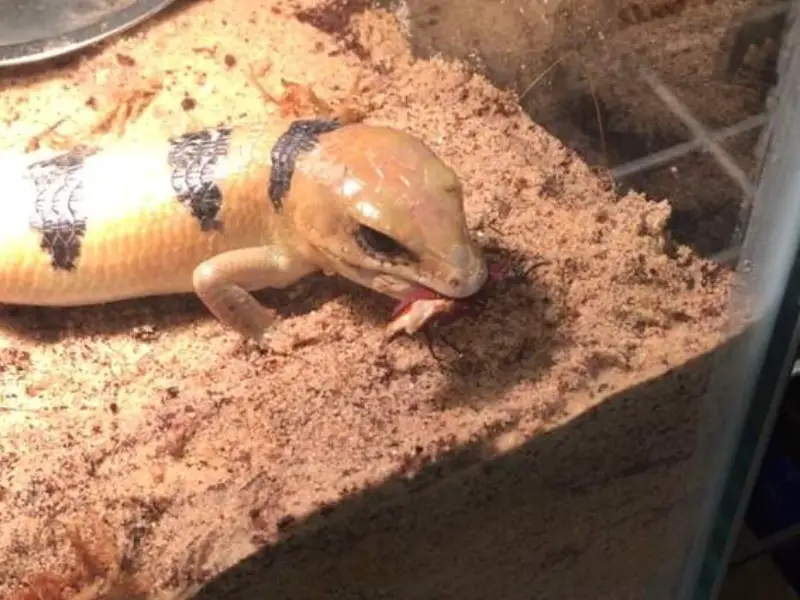
There is some controversy over whether this is a pet for beginners or those with experience.
Some say they make a fantastic entry-level reptile because of their tame nature and tolerance to being handled. However, others say that experience is needed to care for them properly.
As much is unknown, leaving these reptiles in the care of those with experience is safer.
These skinks must live in perfect conditions, with ideal temperatures and humidity levels. They also need feeding regularly.
Food And Water
These skinks are omnivorous and therefore have a varied diet. Their diet should include proteins, vegetables, greens, and fruits. However, they’re rarely seen eating their fruit and vegetables.
You should feed an adult skink every two to three days. There’s no need to worry about portion control – simply allow your skink to eat as much as it wants in a sitting. It would be best if you fed a juvenile skink day.
Here are some of the skink’s favorite foods to eat: crickets, insects, locusts, mealworms, and Dubia roaches.
You can also feed them other proteins, such as canned insects, snails, hornworms, superworms, live bugs, and scrambled eggs.
For fruits and vegetables, you can feed your skink turnip greens, collard greens, peas, carrots, apples, mangos, and blueberries.
These foods should make up around 10% of their diet and can be used more as treats for your pet.
Make sure to dust the insects with calcium and vitamin D3 supplements daily to ensure your skink is getting enough essential vitamins.
These vitamin supplements are even more critical if you don’t have a UVB light.
Ensure that you place a medium to large-sized bowl in your enclosure. Replenish it with fresh water every day.
Lizards habitually use their water bowls as a toilet area, so it’s best to clean them every day. Also, clean the bowl weekly with a safe reptile-friendly disinfectant to remove bacteria.
Handling
It is safe to handle this skink. Unlike many other reptiles, they seem to be very tolerant of and enjoy being held.
But it’s important to start slowly. Although you’ll be excited to hold your skink, it’s best to wait two to three weeks after bringing it home.
Let your skink come to you, and don’t chase it around its enclosure.
When it comes, scoop it up from below and support as much of its body as possible. This hold will make it feel safe and unthreatened.
Return these skinks to their enclosure when they’re calm. They are known to be significantly more relaxed than other reptiles when being held.
You can gradually increase the holding time as you go.
Common Health Issues
Before getting Peter’s banded skink, you should be aware of several health-related issues.
- Parasites: Because they are primarily wild-caught, they may have many parasites, including hookworms, coccidia, and flagellates. You should consult with a veterinarian to screen and treat parasites.
- Skin shedding: Most lizards suffer from abnormal skin shedding at some point. Low humidity levels usually cause it. If you see this happening, you can bathe your skink in warm water for 10-15 minutes and gently remove the unshed skin.
- Respiratory infections: These are usually caused by a change in the environment. Once your skink is accustomed to its new home, this shouldn’t be a recurring problem.
- Skin infections: Skin infections are often caused by a new environment and tend to resolve over time.
For any health problems, consult a trusted veterinarian for diagnosis and treatment.
Breeding
These skinks are generally not bred in captivity as they are fairly new to the pet trade. Very little is known about their reproduction in the wild.
There have been very few reports of breeding in captivity and details have yet to be revealed about the process.
If you’re hoping to breed these reptiles, you’ll need to take the lead and be a pioneer of this process.
Choosing And Buying A Peter’s Banded Skink
The Peter’s banded skink is a relatively low-cost lizard. They can be purchased for anywhere between $70 – $100.
However, as they are new to the reptile trade, it can be challenging to find them. It’s unlikely that you will find them in your local pet store. You will probably have to purchase one online.
It’s recommended to always buy through a reputable, trusted breeder. If you don’t know them, read reviews from several websites to get a complete picture of the seller.
Because these skinks are all wild-caught, they will likely have some health problems like parasites. We always recommend that you have a veterinarian check them over and provide any necessary treatment.
Overall, Peter’s banded skink is a unique lizard with a gentle nature that can make a wonderful pet for many years.

